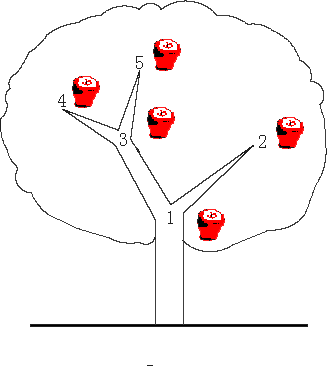POJ 3321 Apple Tree 树状数组
来源:互联网 发布:大连育知同创宿舍 编辑:程序博客网 时间:2024/05/17 07:11
Description
There is an apple tree outside of kaka's house. Every autumn, a lot of apples will grow in the tree. Kaka likes apple very much, so he has been carefully nurturing the big apple tree.
The tree has N forks which are connected by branches. Kaka numbers the forks by 1 toN and the root is always numbered by 1. Apples will grow on the forks and two apple won't grow on the same fork. kaka wants to know how many apples are there in a sub-tree, for his study of the produce ability of the apple tree.
The trouble is that a new apple may grow on an empty fork some time and kaka may pick an apple from the tree for his dessert. Can you help kaka?

Input
The first line contains an integer N (N ≤ 100,000) , which is the number of the forks in the tree.
The following N - 1 lines each contain two integers u and v, which means forku and forkv are connected by a branch.
The next line contains an integer M (M ≤ 100,000).
The following M lines each contain a message which is either
"C x" which means the existence of the apple on fork x has been changed. i.e. if there is an apple on the fork, then Kaka pick it; otherwise a new apple has grown on the empty fork.
or
"Q x" which means an inquiry for the number of apples in the sub-tree above the forkx, including the apple (if exists) on the fork x
Note the tree is full of apples at the beginning
Output
Sample Input
31 21 33Q 1C 2Q 1
Sample Output
32
Source
ACcode:
#include <cstdio>#include <cstring>#include <stdlib.h>#include <iostream>#define maxn 100000+5using namespace std;struct node1{ int next; int tail;}edge[maxn];struct node2{ int r,l;}apple[maxn];int s[maxn],cnt,c[maxn],a[maxn];void dfs(int u){///从节点u出发,计算每个节点为根的子树区间[apple[].l,apple[].r] apple[u].l=cnt; for(int i=s[u];i!=-1;i=edge[i].next) dfs(edge[i].tail); apple[u].r=cnt++;}inline int lowbit(int x){ return x&(-x);}void change(int x){ if(a[x]) for(int i=x;i<cnt;i+=lowbit(i)) c[i]++; else for(int i=x;i<cnt;i+=lowbit(i)) c[i]--;}int sum(int x){ int i,res=0; for(i=x;i>0;i-=lowbit(i)){ res+=c[i]; } return res;}int main(){ int n,m,t1,t2,t,i; char str[3]; scanf("%d",&n); memset(s,-1,sizeof(s[0])*(n+1)); memset(c,0,sizeof(c[0])*(n+1)); memset(apple,0,sizeof(apple[0])*(n+1)); for(i=0;i<n-1;++i){ scanf("%d%d",&t1,&t2); edge[i].tail=t2; edge[i].next=s[t1]; s[t1]=i; } cnt=1; dfs(1); scanf("%d",&m); for(i=1;i<=n;++i){ a[i]=1; change(i); } while(m--){ scanf("%s%d",&str,&t); if(str[0]=='Q') printf("%d\n",sum(apple[t].r)-sum(apple[t].l-1)); else{ a[apple[t].r]=(a[apple[t].r]+1)%2;///0--->1 1---->0; change(apple[t].r); } } return 0;}- poj 3321 Apple Tree( 树状数组 )
- POJ 3321 apple tree 树状数组
- POJ 3321 Apple Tree(DFS+树状数组)
- POJ 3321 Apple Tree 树状数组
- poj 3321 apple tree 树状数组 水
- POJ 3321 Apple Tree(DFS+树状数组)
- POJ 3321 Apple Tree 树状数组
- POJ 3321 Apple Tree (树状数组)
- POJ 3321 Apple Tree (dfs + 树状数组)
- POJ 3321 Apple Tree (DFS + 树状数组)
- Poj 3321 Apple Tree - 树状数组
- [poj 3321]Apple Tree[树状数组]
- POJ 3321 Apple Tree DFS + 树状数组
- POJ 3321 Apple Tree(树状数组)
- POJ 3321 Apple Tree(dfs+树状数组)
- poj 3321 Apple Tree 树状数组
- poj-3321 Apple Tree(树状数组)
- POJ 3321 Apple Tree【树状数组】
- Qt 元对象系统 一
- 实现PHP的编译执行分离(separatingcompilation and execution)
- angular 封装 Jquery插件时作用域问题
- HDU 1038.Biker's Trip Odometer【单位换算】【水水水】【8月24】
- PHP的单引号和双引号
- POJ 3321 Apple Tree 树状数组
- 使用Go快速创建静态服务
- EBS中odf文件和xdf文件解释
- hdu--5137
- 8月7日 XE8移动开发入门(一) RadStudio XE8开发环境简介(免费培训)
- 开博之说
- UINavigationBar背景颜色
- Cocos2d-x_创建多个滚动层(每层速度不同)
- Check the difficulty of problems POJ 2151


